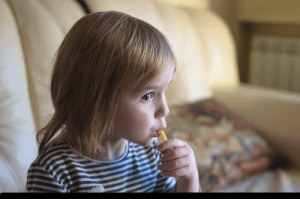Everything You Need to Know About Pica

At some point, you might find your child eating, licking, or biting something that they shouldn’t. It could be plasticine, glue, crayons, mud, etc. This behavior is known as pica.
It’s a food-related behavioral condition. Children suddenly feel the urge to eat things that aren’t foods and could even be dangerous for their health. This urge is almost uncontrolable.
It’s considered to be normal for children to try eating non-food items until they’re 18 or 24 months old. If this behavior persists beyond this age, then it’s considered a disorder, so pay attention.
Why does it happen?
Pica is a sign of an imbalance, whether it be organic (lack of nutrients) or psychological (mental disorders, intellectual disability). This means that the causes will be different on a case-by-case basis. To identify it properly, it’s important to go to a health professional so that you can get the right treatment.
Pica is a condition or disorder where the child (or adult) displays illogical behavior with respect to food.
A child or person who suffers from pica might indiscriminately eat dirt, chalk, paper, or sniff nail varnish, coal or even feces (animal or human).
History of Pica
The term “pica” is a reference to a bird, specifically the magpie. This bird has very strange behavior when it comes to feeding itself.

However, pica has also been adopted by various civilizations as a part of rituals or even cures. For example, eating clay is considered to have curative properties, although medically nothing is proven, and nutritionally it’s not acceptable.
Prevalence of Pica
Since this behavior isn’t particularly logical, it’s not easy to foresee and many people won’t admit that they suffer from it.
Furthermore, knowing that they have pica doesn’t make people feel any less embarrassed about it. They know it’s something very unusual and some people just can’t help themselves, even though they know it’s harmful.
If your son or daughter suffers from this disorder, you must take measures to make sure it doesn’t last forever.
If they’re already at an age where they understand reason, you need to speak to them. You should tell them how bad it is to eat these things and why. This way, they’ll be able to understand the problem better and hopefully take mom and dad’s advice.
Risk factors
Now that you know what pica is, it’s easier to understand that the possibility of suffering this disorder is much greater if the family environment is confusing or hostile.
There are also factors which can lead to a family member developing this kind of behavior. They include:
- Addictions to harmful, toxic, or illegal substances.
- Bad influences in their social environment.
- Poor diet at home.
- Lack of affection.
- Mental disability.
- Lack of attention.

Causes
- Nutritional factors: this theory assumes that this disorder is caused by a deficiency of a mineral such as iron or zinc. Pica looks to compensate for the deficiency through ingesting soil.
- Sensorial factors: this assumes that the sufferer irrationally and excessively enjoys the taste, texture, or smell of the thing they’re eating.
- Psychosocial factors: the disorder could be associated with greater and lesser anxiety problems.
Treatment for these types of problems includes the use of medication if your doctor considers it necessary. It may also be necessary to seek psychological treatment and seek expert advice. The important thing is to try and improve their behavior to safeguard their health.
At some point, you might find your child eating, licking, or biting something that they shouldn’t. It could be plasticine, glue, crayons, mud, etc. This behavior is known as pica.
It’s a food-related behavioral condition. Children suddenly feel the urge to eat things that aren’t foods and could even be dangerous for their health. This urge is almost uncontrolable.
It’s considered to be normal for children to try eating non-food items until they’re 18 or 24 months old. If this behavior persists beyond this age, then it’s considered a disorder, so pay attention.
Why does it happen?
Pica is a sign of an imbalance, whether it be organic (lack of nutrients) or psychological (mental disorders, intellectual disability). This means that the causes will be different on a case-by-case basis. To identify it properly, it’s important to go to a health professional so that you can get the right treatment.
Pica is a condition or disorder where the child (or adult) displays illogical behavior with respect to food.
A child or person who suffers from pica might indiscriminately eat dirt, chalk, paper, or sniff nail varnish, coal or even feces (animal or human).
History of Pica
The term “pica” is a reference to a bird, specifically the magpie. This bird has very strange behavior when it comes to feeding itself.

However, pica has also been adopted by various civilizations as a part of rituals or even cures. For example, eating clay is considered to have curative properties, although medically nothing is proven, and nutritionally it’s not acceptable.
Prevalence of Pica
Since this behavior isn’t particularly logical, it’s not easy to foresee and many people won’t admit that they suffer from it.
Furthermore, knowing that they have pica doesn’t make people feel any less embarrassed about it. They know it’s something very unusual and some people just can’t help themselves, even though they know it’s harmful.
If your son or daughter suffers from this disorder, you must take measures to make sure it doesn’t last forever.
If they’re already at an age where they understand reason, you need to speak to them. You should tell them how bad it is to eat these things and why. This way, they’ll be able to understand the problem better and hopefully take mom and dad’s advice.
Risk factors
Now that you know what pica is, it’s easier to understand that the possibility of suffering this disorder is much greater if the family environment is confusing or hostile.
There are also factors which can lead to a family member developing this kind of behavior. They include:
- Addictions to harmful, toxic, or illegal substances.
- Bad influences in their social environment.
- Poor diet at home.
- Lack of affection.
- Mental disability.
- Lack of attention.

Causes
- Nutritional factors: this theory assumes that this disorder is caused by a deficiency of a mineral such as iron or zinc. Pica looks to compensate for the deficiency through ingesting soil.
- Sensorial factors: this assumes that the sufferer irrationally and excessively enjoys the taste, texture, or smell of the thing they’re eating.
- Psychosocial factors: the disorder could be associated with greater and lesser anxiety problems.
Treatment for these types of problems includes the use of medication if your doctor considers it necessary. It may also be necessary to seek psychological treatment and seek expert advice. The important thing is to try and improve their behavior to safeguard their health.
All cited sources were thoroughly reviewed by our team to ensure their quality, reliability, currency, and validity. The bibliography of this article was considered reliable and of academic or scientific accuracy.
- Frenk Silvestre, Faure María Amparo, Nieto Sandra, Olivares Zazil. Pica. Bol. Med. Hosp. Infant. Mex. [Revista en la Internet]. 2013; 70 (1): 58-65. Disponible en: http://www.scielo.org.mx/scielo.php?script=sci_arttext&pid=S1665-11462013000100011&lng=es.
- Padilla, F; Miján, A. La pica: retrato de una entidad clínica poco conocida. Nutr Hosp. 2006;21(5):557-66 ISSN 0212-1611 • CODEN NUHOEQ S.V.R. 318. [Documento en línea] Disponible en: http://scielo.isciii.es/pdf/nh/v21n5/revision.pdf
- Varios autores. Trastornos de la conducta alimentaria en niños y adolescentes. MED UNAB. Vol. 12 Número 3, Diciembre de 2009. [Documento en línea] Disponible en: http://132.248.9.34/hevila/Medunab/2009/vol12/no3/3.pdf
This text is provided for informational purposes only and does not replace consultation with a professional. If in doubt, consult your specialist.








